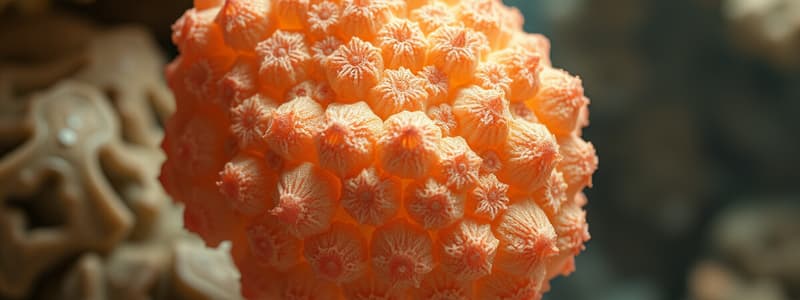Podcast
Questions and Answers
What is Phylum Porifera considered?
What is Phylum Porifera considered?
- Completely unicellular organisms
- A type of mollusk
- The simplest metazoans (correct)
- The most advanced metazoans
What are the chief characteristics of sponges?
What are the chief characteristics of sponges?
Their pores and canal systems, choanocytes, and peculiar internal skeletons of spicules or organic fibers.
What is a spongocoel?
What is a spongocoel?
The internal cavity of a sponge.
What is an osculum?
What is an osculum?
What are spicules?
What are spicules?
What are choanocytes?
What are choanocytes?
What is Grantia classified as?
What is Grantia classified as?
What is the function of radial canals?
What is the function of radial canals?
What are incurrent canals?
What are incurrent canals?
What are dermal ostia?
What are dermal ostia?
What is spongin fiber?
What is spongin fiber?
What is a glass sponge?
What is a glass sponge?
Flashcards
Phylum Porifera
Phylum Porifera
The simplest multicellular organisms with a loose cell aggregation and minimal tissue organization. They lack organs, organ systems, and a digestive tract.
Choanocytes
Choanocytes
These cells line the cavities of sponges and create water currents with their flagella. They are essential for filter feeding and respiration.
Spongocoel
Spongocoel
The central cavity of a sponge, where water circulates. It is connected to the outside via the osculum.
Osculum
Osculum
Signup and view all the flashcards
Spicules
Spicules
Signup and view all the flashcards
Grantia
Grantia
Signup and view all the flashcards
Syconoid Body Plan
Syconoid Body Plan
Signup and view all the flashcards
Radial Canals
Radial Canals
Signup and view all the flashcards
Incurrent Canals
Incurrent Canals
Signup and view all the flashcards
Dermal Ostium
Dermal Ostium
Signup and view all the flashcards
Spongin Fiber
Spongin Fiber
Signup and view all the flashcards
Glass Sponge
Glass Sponge
Signup and view all the flashcards
Study Notes
Phylum Porifera
- Considered simplest metazoans, characterized by loose cell aggregation and minimal tissue organization.
- Exhibit cellular level of organization, with a division of labor among cells.
- Lack organs and organ systems, as well as structures like a mouth or digestive tract.
- Not classified as diploblastic or triploblastic; feature rudimentary nervous integration.
Chief Characteristics of Sponges
- Defined by pores and canal systems facilitating water flow.
- Choanocytes, flagellated feeding cells, line cavities to create water currents.
- Possess an internal cavity known as the spongocoel, which opens to the outside via the osculum.
- Internal skeletons made of spicules or organic fibers like spongin.
Spongocoel
- Central cavity of the sponge that operates as a chamber for water circulation.
Osculum
- The opening at the terminal end of the sponge, functioning similarly to a mouth, allowing water to exit.
Spicules
- Microscopic skeletal elements made of calcium carbonate or silica, contributing to sponge structure and protection.
Choanocytes
- Specialized cells that line the interior cavities and are responsible for creating water currents, which aids in feeding and respiration.
Grantia
- A genus of calcareous marine sponges within the phylum Porifera.
- Colonial, benthic, and sessile filter feeders, typically asymmetrical in shape.
- Sometimes referred to as Scypha in older literature.
Structure of Grantia (Sycon)
- Specific structural adaptations that include a syconoid body plan, allowing for greater surface area and efficiency in water filtration.
Radial Canal
- Canals lined with flagellated cells, closed at one end and opening into the central cavity.
- Does not have direct connection to the external environment, serving as a passageway for water.
Incurrent Canals
- External spaces between enclosed canals, leading into the sponge while ending blindly at the inner end.
Dermal Ostium
- Minute openings on the sponge surface that provide access to the incurrent canals, facilitating water intake.
Spongin Fiber
- Type of collagen protein forming the fibrous skeleton of many sponges, secreted by spongioblasts.
- Provides flexibility and is characteristic of members in the class Demospongiae.
Glass Sponge
- Specialized sponges known for their silica spicules, distinguishing them from other sponge types.
Studying That Suits You
Use AI to generate personalized quizzes and flashcards to suit your learning preferences.




